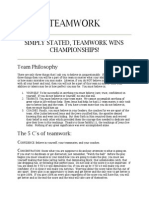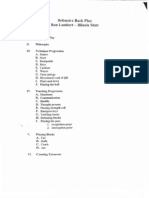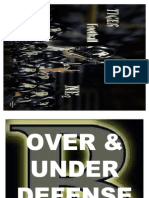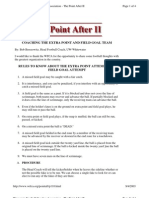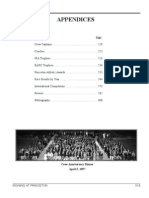Defending The Wing T
Defending The Wing T
Uploaded by
Matthew LooneyCopyright:
Available Formats
Defending The Wing T
Defending The Wing T
Uploaded by
Matthew LooneyOriginal Title
Copyright
Available Formats
Share this document
Did you find this document useful?
Is this content inappropriate?
Copyright:
Available Formats
Defending The Wing T
Defending The Wing T
Uploaded by
Matthew LooneyCopyright:
Available Formats
Smoke, Mirrors, & Speed
Defending the Mighty Wing-T with Hustle and Guile
By Matthew Brophy
Formations
The Wing T and Double Wing offenses are premised with the guise of an
aggressive, quick hitting run game with the element of misdirection. Stopping the speed
sweep, power, Iso, 3 step passing game, and sprint out series of the offense is a different
animal altogether, so for the sake of brevity in this discussion, we will zero our efforts on
stopping the unique threats of this offense
First things first, what are you initially defending? The formation. Wing teams
commonly use the double-tight double wing, single-wing, or single wing with flexed split
end. All these formations can be handled separately in their own right and aligning your
players to attack the formation is the primary key. Next, what does the wing team you’re
facing do out of these formations and how do you intend to defend this from a coverage
and run support perspective. Many teams will only run specific plays out of particular
formations. Because the footwork is affected when back alignment is altered, teams may
become predictable from a formation standpoint. We will explore WHAT these teams do
and how the defense can increase its odds of stopping the offense.
Belly Series
The belly is the bread-and-butter ‘power football’ for this offense. Most Wing T
offenses are built with this series in mind and coordinate their personnel with this
premise. They can operate with suspect athletes at all positions, but you’ll find that most
teams that run the Wing T / Double Wing, they take pride in putting large, powerful
athletes on the line. The Belly series features three front side rushing attack points and is
complimented by an explosive play action boot game.
When facing a potent Wing T team, understand you will probably never truly shut
this brute-force attack with scheme, but keep the basics in perspective. As long as you
can keep them out of their comfort zone, you begin to put tremendous strain on an
offense not known for scoring quickly.
First thing, teams that run the belly, do so because they spend in inordinate
amount of time repping this series to perfection. The timings of the backs, footwork of
the QB, and the minutiae of the mesh point on
exchanges is a science in and of itself. So much time
devoted to this series leaves little time to ‘perfect’
other facets or attacks of their offense. This is not a
shortcoming, but a truth. Frustrate their belly series;
get them out of their rhythm, and irritate their linemen
by making them work / efforting to find their blocks.
Wing T teams pride themselves on brute linemen
play. As long as you sit still, you are playing into
their hands. Being an undersized team and playing the
Nickel defense, we acknowledge that if we were to go
toe-to-toe, man-for-man, we will be physically
@BCL@C408C160.doc by Matt Brophy Page 1 2/8/2006
outmatched. We don’t enter into this arena with a stacked deck – we intend to use our
speed as an equalizer to size. Our players are wound and ready to be fired from the snap,
therefore as coaches, it’s our job to 1) put them in positions to make plays and 2) protect
them (limit the toe-to-toe matchups we probably won’t win).
We have found a few successful concepts in stacking the odds in our favor defensively
against Wing T teams (Smoke & Mirrors).
I. Play balanced – keep the MLB free to attack the FB and
nothing else. Three benefits can result from this.
a. Since the FB is capable to attack either side of the ball, now you have a
dedicated defender to this major rushing threat. The Wing T backs are
trained to NEVER cut back until he’s beyond the linebackers – pursuit can
help get a steady bead on this player because of that.
b. Playing even lends itself to a favorable defensive match up; Our (best
athlete) MLB versus your (not-so-great athlete) Center. The center will
largely be responsible for handling the MLB because of the even
alignment of the defense. Not only will he have to snap the ball, but also
he will have to have considerably more mobility than your MLB to get
him blocked. Odds are for the defense in that contest.
c. Because you are even (coverage) the main areas to be threatened in the
passing game lay in the perimeter in the flats, in the curl seams, and the
deep out. The man you can ‘sacrifice’ in zone coverage here more often
than not is the MLB. Blitzing the MLB and / or using stunts with the MLB
and any of the other two interior tackles allows for effective penetration
either to disrupt long-developing backfield actions such as the dreaded
double-handoff or cross buck and aid in pressuring a throwing
quarterback.
II. Alternating base personnel
a. Stopping the inside belly requires quickness not strength. If you are
playing ‘speed defense’ it’s probably a result of not having the most
physically imposing athletes to begin with. Don’t bring a knife to a
gunfight when you can bring a grenade - explosive athletes in the ‘A’ gaps
can cause more problems for the belly than a 300lbs kid that can’t get out
of his stance before the linebackers are reached. Instead, try inverting your
personnel. Put the explosively quick athletes in the interior positions
(especially the nose) and put your bigger hosses on the perimeter
(especially the strong side end). The outside hitters of the Wing T take a
little more time to develop and require help from either the HB or TE.
Moving your bigger athletes could be a chore for them rather than pushing
over your smaller ‘base’ package ends. In the Wing T offenses, you will
rarely find highly motivated tight ends. They will either be smaller
linemen who are not physical enough to be tackles or guards, or tall kids
who aren’t very fast. By inverting your linemen, you are picking your
battles wisely and winning the wars you CAN win.
@BCL@C408C160.doc by Matt Brophy Page 2 2/8/2006
III. Twist your Strong side personnel
a. Leaving your SOLB on the nub can make for a boring day for him. Get
him involved in the game plan and keep your opponent guessing. Blitzing
the SOLB into the “C” gap and looping your SDE outside can help open
unexpected shots of opportunity that the offense cannot account for. This
type of stunt is best supported by rolling coverage to the tight end side or
gambling on non-passing downs. Just like mixing up QB option
responsibilities irritates the option game, so do perimeter twists on powers
and sweeps.
b. Playing a tight SOLB and twisting your 3 technique and your 6 technique.
The change up allows a cluster of mayhem and aggressive penetration by
your defensive end crashing into the play side guard and crossing the face
of the tackle (disrupting any counter action weak).
IV. Wedging 4 for 6 Advantage
a. When facing foot-to-foot splits of many double wing teams, we realize
that stunting and blitzing will be largely ineffective. Also, to maintain the
‘sportsmanship’ of the game, we want to avoid the temptation to sub
linemen and grab ankles. This is not a very competitive method of playing
football and is rather cowardly, in my opinion. We at least want to
maintain our aggressive attitude while giving each player a sporting
chance. To bust the ‘wedge’, we want to level the scales of the game in
our favor by forcing the offense to negotiate the field on our terms –
negating your size and playing to our speed. We want to bounce you
outside and open gaps we can run through. We will play two 3 techniques
and two 6 techniques and knife our linemen a full gap inside. We will tilt
all the linemen inside and charge hard at the snap, staying low, keeping
our INSIDE shoulder free. We want to accomplish two things; 1) create an
inside wash of players to take away dive and 2) penetrate and disrupt and
pulling by tackles or guards. We want to spill the ball carrier and force
you to give to your wingback for a slower developing sweep to contend
with scraping linebackers, corner force, and a filling safety.
V. Call strength away from the wing back
a. Many times you will face a Wing T team that will favor a particular back
or will go to an Ace (double wing) formation in an attempt to better out-
flank the defense. Putting your strong side personnel puts them at a greater
advantage as they are more aggressive and more likely to pull the trigger
on run support, cutting off perimeter lanes to a great runner. The more
hesitation you can cause the wing prior to approaching the LOS, the better
your chances are. Allowing a wing back (that will likely be executing
some sort of motion and gaining momentum before receiving the ball) to
not be forced with a decision until breaking the plane of scrimmage, never
is good for a defense.
@BCL@C408C160.doc by Matt Brophy Page 3 2/8/2006
VI. Keys, Reads, and Seeds
Nothing is more important in defending the Wing T / Double Wing than
teaching your players basic football. The what, whys, and hows (rationale) of
your opponent’s offense. A great example is instructing players to take on
lead blockers on the perimeter – many will try to go solo and try to make a
play all by themselves, while opening running lanes - but if you can show
them (sell them) on how, if the defense can cause disruption and/or take out
more than one blocker and constrict the running lane, they enable the rest of
the team defense to make a negative yardage play by allowing pursuit to clean
up the ball carrier. How to play your defense is one thing, teaching your
defensive players what the offense DOES NOT want to see is another. Enable
and empower your players with ownership of the defense’s success.
a. Keys – These are the presnap clues to our players. If I’m a perimeter force
player, I’m keying the EMOL / wing to see if he will tip off where he is
headed at the snap. Does the wing turn his shoulders more to better
execute a flare / arc release? Is the wing’s shoulder more parallel? Will he
be blocking / sealing inside? Use video to teach your backers / corners
what to look for and notice the tendency of the wing’s presnap alignment
for a given play / series. The biggest key will be found at the guard spots
and will clue your linebackers to potential powers, traps, or pass. Very few
Wing T guards are disciplined enough to maintain neutral stances and
because of the speed needed to open and pull, many lift considerable
weight off their forward set hand and will even go as far as leaning
backwards in their stance (further taking weight off their forward lean).
Start training the backers by showing them the linemen’s stance when
running dive and other inside drive blocking plays. Then progress to pass
and counter / super power plays so they subtleties can be noticed.
b. Reads – Reads to us are what we see developing in front of our eyes. The
Wing T defense relies largely on efficient movement with little thought,
because of the precision execution of the successful belly teams; a defense
that does not react (and quickly) will find itself with few answers.
i. On perimeter force players, if the wing vacates (motion away) we
want our players gaining (slight) width and gaining depth.
“Anytime you’re unsure, get width get depth…don’t fall into a
trap”.
ii. If the Wing fires out, as a force
player we want to keep the outside
shoulder free and aggressively work
to the depth of 2 yards in the
offensive backfield to redirect flow
back to help. With our OLBs who
are not force players, they also have
the rule of keeping the outside
shoulder free, but we want them
scraping hard and ripping through
blockers (sweep) while penetrating
@BCL@C408C160.doc by Matt Brophy Page 4 2/8/2006
into the offensive backfield. On sweeps, the OLB will be the true
cutoff player here.
iii. If the Wing blocks down, more than likely we’re looking at a
power play, and we are looking to take on / eliminate the load
block by a pulling guard. Special care has to be taken to coach
aggressive play, but not over penetration. One step is too little;
three are too many, two is just right.
iv. For the inside linebacker, reading guards and fullback and having a
response for each is vital.
The backer looks to fullback
for his first read step, then
cross-keys with the guards.
As the figure illustrates, if
backside opens and pulls
across the formation the
backer holds to the opposite
“A” gap, looking to spill trap.
If the guard opens to the
outside of the formation, he
immediately is keyed that
this is sweep or power and
must look to scrape outside to “C” gap and help support the SOLB.
Upon seeing this reaction, he can anticipate the impending down
block by the EMOL and get in
better position to attack his outside
shoulder with an escape.
v. For the Outside backer, these reads
work in much the same manner. If
guard pulls TO, the backer
immediately fills his play side gap
responsibility. If the guard pulls
AWAY, the backer looks to
aggressively charge the open “A”
gap and run thru the vacated gap.
If wing motions away, the backer
looks to hesitate to get a true read
and gain width and depth to clear
from blockers.
@BCL@C408C160.doc by Matt Brophy Page 5 2/8/2006
vi. Seeds – As corny as this sounds, it cannot be discounted. Going
beyond telling your players football, it is imperative when facing
the wing T to plant as much intuition (seed) into your players as
possible. Wing T teams are seldom unpredictable in their play
calling – many follow a basic style or comfort zone and have
tendencies. “Long yardage situation? Look for double-handoff or
some other misdirection…etc”. Because this offense operates so
quickly, there will be very little time to THINK on the field. This
is why I stress planting the seeds of anticipating plays / areas of
probable attack. Anticipating cadence (and how belly motion is
tied to it), positioning of wingbacks, and linemen stance tendencies
during the course of a game are all elements you players must be
given. When you plant a garden, when you plant 14 seeds you
cannot expect to see 14 sprouting buds. Not every seed germinates
– therefore you must inundate your players with redundant
information from various forms of media…chalk board, video,
printed handouts, send home video, field time, etc… repeating the
message(s) over and over. So that by Friday night, you have
natural responses instead of spontaneous reactions.
@BCL@C408C160.doc by Matt Brophy Page 6 2/8/2006
Cross Buck
The cross buck is the home-run hitter of the wing-T. When it’s run, it usually
results in big yards because your defense will be lulled into complacency for the backside
counter. The fullback dive action is simulated then the counter action of the halfback
retracts the steps against flow being led by the backside guard kicking out pursuit and
gashing your defense.
Naturally, to stop
counter action, your backside
support must remain sound.
The diagram depicts initial
flow to the right.
The players illustrated in red
show your backside support
players that must play
disciplined to cut off the cross
buck. With the penetration you
should be getting upfront, you
should at least cause some
hesitation by the countering
halfback. In the event that has
no effect, training the backside
linebacker and safety to work in conjunction is the key. Training your players to remain
gap conscience and recognizing that gaps are the spaces between players and can move –
they in turn must also adjust / move.
The backside linebacker we want closing “B” gap and then moving to stack behind the
eventual double-team of the nose. The safety, whose support is probably the most critical,
is trained to fit outside the backer and inside the corner. It is imperative that in screwing
down to the ball, he does NOT flow past the near side “A” gap. If this happens, he will
have over pursued and opened up the cutback lane.
I hope you’ve gained some ideas or a different perspective on how we handle and attempt
to corral this great offense and wish the greatest success (as long as it isn’t against me) in
the future. Feel free to contact me for any questions or comments at;
mjbrophy@netexpres.net - Yours in football.
@BCL@C408C160.doc by Matt Brophy Page 7 2/8/2006
You might also like
- Play Tennis Manual PDFDocument52 pagesPlay Tennis Manual PDFAnonymous GJuRvp9A5T100% (2)
- Franken Armor v1Document10 pagesFranken Armor v1葉柏誼No ratings yet
- The Gap 8 DefenseDocument79 pagesThe Gap 8 DefenseBrian Jackson100% (1)
- Epic 1st Space MarineDocument52 pagesEpic 1st Space Marineandy_cole@talkltal100% (9)
- VTM 5th - Rules SummaryDocument1 pageVTM 5th - Rules SummaryJuhász ZoltánNo ratings yet
- The Fly OffenseDocument3 pagesThe Fly OffenseMichael SchearerNo ratings yet
- 5-3 Defense PlaybookDocument76 pages5-3 Defense PlaybookBuzzard951111100% (3)
- 4 4 DefenseDocument2 pages4 4 DefenseRoss Runnels100% (1)
- G DefenseDocument6 pagesG DefensebrittchrNo ratings yet
- Illinois State Defensive Back Manual by Ron LambertDocument39 pagesIllinois State Defensive Back Manual by Ron LambertUzi BeeNo ratings yet
- Wwii Pre GensDocument3 pagesWwii Pre GensLuis Antonio Pelozo100% (1)
- Practice ProblemsDocument4 pagesPractice ProblemsArvind KumarNo ratings yet
- College Football Schemes and Techniques: Offensive Field GuideFrom EverandCollege Football Schemes and Techniques: Offensive Field GuideRating: 3 out of 5 stars3/5 (1)
- Effective Zone Offenses For The High School Coach: Winning Ways Basketball, #3From EverandEffective Zone Offenses For The High School Coach: Winning Ways Basketball, #3No ratings yet
- How to Speak Football: From Ankle Breaker to Zebra: An Illustrated Guide to Gridiron GabFrom EverandHow to Speak Football: From Ankle Breaker to Zebra: An Illustrated Guide to Gridiron GabNo ratings yet
- Spread Option Run & Shoot by Ted SeayDocument30 pagesSpread Option Run & Shoot by Ted SeayTroof10No ratings yet
- Wake Forest Outside ZoneDocument30 pagesWake Forest Outside ZoneDobsonFootballNo ratings yet
- AVENGERS Single Wing Offense: Coach Keith James Gilbert Pop Warner Gilbert, ArizonaDocument27 pagesAVENGERS Single Wing Offense: Coach Keith James Gilbert Pop Warner Gilbert, Arizonasprintout100% (1)
- Over Under Defense 2011Document34 pagesOver Under Defense 2011Chad Jamerson100% (1)
- 63 Basics and OverviewDocument76 pages63 Basics and Overviewstevel75100% (1)
- Shooter 62Document30 pagesShooter 62CoachHuffNo ratings yet
- Defending The Double WingDocument20 pagesDefending The Double WingCoach BrownNo ratings yet
- Field Goal Team WisconsinDocument4 pagesField Goal Team Wisconsindelgadog125607No ratings yet
- 2004 Villanova 4-2-5 DefenseDocument260 pages2004 Villanova 4-2-5 Defensemtf1179No ratings yet
- Playbook - Drawing Up A 'Cover 0' Blitz SchemeDocument2 pagesPlaybook - Drawing Up A 'Cover 0' Blitz Schemewill27nsNo ratings yet
- Three Tight End Offensive FormationDocument8 pagesThree Tight End Offensive FormationFirmansyah Ava100% (1)
- Nickel Vs SpreadDocument5 pagesNickel Vs SpreadguelfiNo ratings yet
- The Bandit Defense by Peter TosDocument6 pagesThe Bandit Defense by Peter TosJunior Leoso100% (1)
- Block Down-Step Down DLDocument2 pagesBlock Down-Step Down DLtoramsfan8632No ratings yet
- 01 James Vint - Pistol 5-Step Pass GameDocument84 pages01 James Vint - Pistol 5-Step Pass Gamelol100% (1)
- Griffins Defensive Playbook Amsterdam 2011Document28 pagesGriffins Defensive Playbook Amsterdam 2011JB WellsNo ratings yet
- 4 4 3 Stack DefenseDocument20 pages4 4 3 Stack DefenseChris RatkayNo ratings yet
- Power Spread Offense Sample ChaptersDocument17 pagesPower Spread Offense Sample ChaptersAndrew Kershner50% (2)
- Presented By: Tim Murphy Head Football Coach Clovis East High SchoolDocument24 pagesPresented By: Tim Murphy Head Football Coach Clovis East High Schoolcanuck68100% (1)
- Implementing The Zone Running Game - The Stretch PlayDocument63 pagesImplementing The Zone Running Game - The Stretch PlayCoach Brown100% (1)
- Defending The SpreadDocument2 pagesDefending The SpreadJB WellsNo ratings yet
- 53 DefenseDocument35 pages53 DefenseEmma FoxNo ratings yet
- Olivet Jet Sweep SeriesDocument21 pagesOlivet Jet Sweep SeriesDobsonFootballNo ratings yet
- This Is Part 1 of A 2Document121 pagesThis Is Part 1 of A 2Heitor Medeiros100% (4)
- Blocking The One Back Power GameDocument9 pagesBlocking The One Back Power GameMike PopeNo ratings yet
- Defensive Football BasicsDocument20 pagesDefensive Football BasicsFballGuru100% (1)
- Defending The Best Offensive Minds - Georgia Offensive Coordinator Mike BoboDocument8 pagesDefending The Best Offensive Minds - Georgia Offensive Coordinator Mike BoboDenauld William BrownNo ratings yet
- Delton Run Game 4-5-10Document30 pagesDelton Run Game 4-5-10ram52100% (1)
- Zone BlitzDocument6 pagesZone BlitzZair100% (1)
- Basic Concepts For The Pistol OffenseDocument77 pagesBasic Concepts For The Pistol Offensecoachyoung100% (4)
- The QB Mentor: Words of Wisdom From an NFL Veteran For An Injured Quarterback That Can Improve Your Life and CareerFrom EverandThe QB Mentor: Words of Wisdom From an NFL Veteran For An Injured Quarterback That Can Improve Your Life and CareerNo ratings yet
- Old Fashioned Football for Secondary Schools in the Twenty-First CenturyFrom EverandOld Fashioned Football for Secondary Schools in the Twenty-First CenturyNo ratings yet
- Winning Concepts for Coaching Winning Football: Learn from the MastersFrom EverandWinning Concepts for Coaching Winning Football: Learn from the MastersRating: 5 out of 5 stars5/5 (1)
- Chalk Talk: An Analysis of the Philosophies of Oregon Football CoachesFrom EverandChalk Talk: An Analysis of the Philosophies of Oregon Football CoachesNo ratings yet
- Win the Line, Win the Edge: A Blueprint for Coaching Football’s Offensive LineFrom EverandWin the Line, Win the Edge: A Blueprint for Coaching Football’s Offensive LineNo ratings yet
- Touchdown: The Power and Precision of Football's Perfect PlayFrom EverandTouchdown: The Power and Precision of Football's Perfect PlayRating: 3 out of 5 stars3/5 (4)
- Youth Football Skills & Drills: A New Coach's GuideFrom EverandYouth Football Skills & Drills: A New Coach's GuideRating: 5 out of 5 stars5/5 (1)
- Northern Iowa 3-4 DefenseDocument40 pagesNorthern Iowa 3-4 DefenseCoach BrownNo ratings yet
- 425 Pressure DefenseDocument15 pages425 Pressure DefenseCoach Brown100% (4)
- Leadership: Building Leaders Building WinnersDocument25 pagesLeadership: Building Leaders Building WinnersCoach BrownNo ratings yet
- PEDocument3 pagesPEVincent ArcallanaNo ratings yet
- Esquema Placa Circuit HHO - PCB Page 1 of 1Document1 pageEsquema Placa Circuit HHO - PCB Page 1 of 1PezhyNo ratings yet
- Car Wars #06 - Mean StreetsDocument194 pagesCar Wars #06 - Mean Streetslerainlawliet100% (3)
- 30th WB State Fide Rated Age Gr. Chess Championship-2018 (Open) /if Aicf Registration Due, Can Not Play Starting Rank No. Name Fideid Fed RTG SexDocument3 pages30th WB State Fide Rated Age Gr. Chess Championship-2018 (Open) /if Aicf Registration Due, Can Not Play Starting Rank No. Name Fideid Fed RTG SexRam KNo ratings yet
- Dd5e Old Gus Wanderers of The Infinite Skies v309 FinalDocument467 pagesDd5e Old Gus Wanderers of The Infinite Skies v309 FinalQuack100% (4)
- Improved TXT GBA RomsDocument49 pagesImproved TXT GBA Romslessons20scribdNo ratings yet
- Game Theory Strategies For Decision Making - A Case Study: N. Santosh RanganathDocument5 pagesGame Theory Strategies For Decision Making - A Case Study: N. Santosh RanganathSofia LivelyNo ratings yet
- PSF-20 Christmas PuzzlesDocument11 pagesPSF-20 Christmas PuzzlesSzilvia Németh-JoóNo ratings yet
- Homework Monopoly GameDocument5 pagesHomework Monopoly Gameafeungtae50% (2)
- Grand Theft AutoDocument21 pagesGrand Theft AutoNurma Widya PangastutiNo ratings yet
- The Effects of Online Gaming Towards The Academic Performance of Selected Grade 12 StudentsDocument13 pagesThe Effects of Online Gaming Towards The Academic Performance of Selected Grade 12 StudentsJoe Daryl100% (6)
- Innovation Management and New Product Development (Nintendo Wii)Document21 pagesInnovation Management and New Product Development (Nintendo Wii)Arjun Pratap Singh100% (1)
- Game Treatment DocumentDocument10 pagesGame Treatment Document9853467No ratings yet
- Team BuildingDocument7 pagesTeam BuildingVimto2009100% (2)
- Chess Tactics Volume 3 - Carsten HansenDocument524 pagesChess Tactics Volume 3 - Carsten HansenJan100% (1)
- Rowing 519-581Document63 pagesRowing 519-581John BartuczNo ratings yet
- KDE TCG Tournament Policy 1 4Document16 pagesKDE TCG Tournament Policy 1 4IphielNo ratings yet
- Achievements Guide v0.20Document5 pagesAchievements Guide v0.20rblox0226No ratings yet
- ADP1-03 A Chance To Serve (3E)Document19 pagesADP1-03 A Chance To Serve (3E)Magus da RodaNo ratings yet
- English Test: Aprotrain - Aptech Computer Education Reading ComprehensionDocument7 pagesEnglish Test: Aprotrain - Aptech Computer Education Reading ComprehensionMai MitNo ratings yet
- Home of The Yellow Jackets & "The West Coast Single Wing": 5 T 4 3 2 1 6 C G G TDocument44 pagesHome of The Yellow Jackets & "The West Coast Single Wing": 5 T 4 3 2 1 6 C G G TKWillNo ratings yet
- वार्षिक - परीक्षा - पेपर 6 अंग्रेजी shalasugam.com 2023Document2 pagesवार्षिक - परीक्षा - पेपर 6 अंग्रेजी shalasugam.com 2023ramawat.ashok85No ratings yet
- Shadowfist PbtA (FC)Document37 pagesShadowfist PbtA (FC)Sebestyén Dániel Nimród100% (1)
- 자동화설비Document340 pages자동화설비어촌김씨 (어촌김씨)No ratings yet







